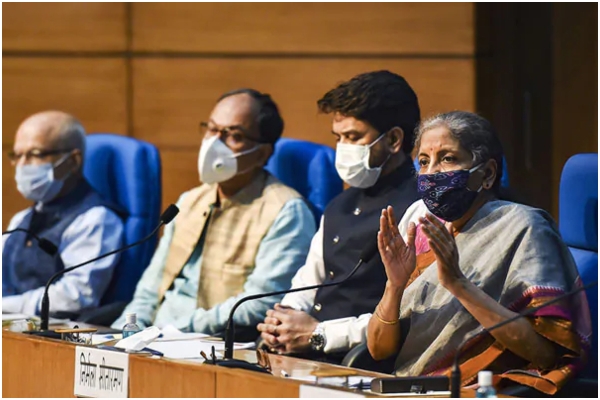What government has proposed in new LTC scheme
Total Views |
New Delhi, October 13: Finance Minister Nirmala Sitharaman Monday announced two sets of measures to generate consumption demand and boost capital spending in the economy. The measures announced by the government, along with participation of states and the private sectors, are, according to the government, projected to create “additional demand” of Rs 1 lakh crore in the economy. Sitharaman said supply constraints in the economy have eased, but consumer demand is still affected. Some proposals are aimed at advancing expenditure while others are “directly linked to increase in GDP (Gross Domestic Product)”, she said.
The ministry has decided to allow government and private sector employees to use their Leave Travel Concession tax-free benefit for various types of purchases subject to certain conditions while an interest-free festival advance of Rs 10,000 is being given to government employees. Measures have been announced to step up capital expenditure by the Centre and the states.

How does the LTC benefit impact you?
The government on Monday announced that Central Government employees will be provided tax benefits on LTC component without them having to actually travel. These employees would, however, be required to spend three times of the LTC fare component for purchasing items that attract 12 per cent or more GST. What this effectively means is that if your fare component of LTC is Rs 40,000, you need to spend Rs 1.2 lakh on goods that fall in 12% or more GST slab in order to save tax on Rs 40,000.
On the other hand, if you don’t spend that amount, you may have to pay tax as per your marginal tax rate on the LTC component. So if you fall in 10% tax slab, you will have to pay additional tax of Rs 4,000 and if you fall in 30% tax slab, you will have to pay additional tax of around Rs 12,000 on the LTC fare amount of Rs 40,000. As for the leave encashment component of LTC, the employee will have to spend an equivalent amount towards the purchase of goods that attract GST of 12 per cent or more.
The second part of the Modi Govt's plan to boost consumer demand is a one-time restoration of the festival advance for central govt employees through the Special Festival Advance Scheme. This is expected to generate at least about Rs 8,000 crore of demand. pic.twitter.com/YnvdCTsnfE
— Nirmala Sitharaman Office (@nsitharamanoffc) October 12, 2020
What benefit will it give to the economy?
Through the LTC consumption boost plan, the government expects a demand generation of Rs 28,000 crore in the economy. While it expects additional demand creation of around Rs 19,000 crore on account of demand from central government employees, it expects additional demand generation of another Rs 9,000 crore from state government employees. Besides, the government has said that the same benefits will be available to private-sector employees if the employers decide to offer the scheme to their employees and they decide to avail it.
How does it benefit the government’s revenue?
While GST collections have been severely impacted in the first half of the fiscal due to Covid-19 pandemic, a consumption boost from LTC component of the salary of central and state government employees will lift GST collections in the second half of the year as the scheme calls for expenditure to be done till March 31, 2021. If private sector employees also participate, it may lead to a significant jump in overall consumption and rise in GST collections.
What is the special festival advance scheme?
The government has restored festival advance, which was abolished in line with recommendations of the 7th Pay Commission, for one time till March 31, 2021. Under this, all central government employees will get interest-free advance of Rs 10,000 that the government will recover in 10 instalments. It will be given in the form of a pre-loaded Rupay card of the advance value and the government expects to disburse Rs 4,000 crore under the scheme. According to the finance ministry, if all states provide similar advance, another Rs. 8,000 crores is likely to be disbursed. This is expected to generate consumption demand ahead of festivals like Diwali.
The LTC Cash Voucher Scheme has the potential to generate demand worth about Rs 28,000 crore. (2/2) pic.twitter.com/I7142bzjig
— Nirmala Sitharaman Office (@nsitharamanoffc) October 12, 2020
What are the measures to boost capital expenditure and their impact?
Special assistance will be provided to states in the form of interest-free 50-year loans of Rs 12,000 crore with certain conditions. States have been categorised among three groups: Group 1 having north-eastern states (Rs 1,600 crore) and Uttarakhand and Himachal Pradesh (Rs 900 crore), Group 2 having other states which will get Rs 7,500 crore in proportion of their share as per Finance Commission devolution, and Group 3 having states which will get total Rs 2,000 crore if they meet three out of four reforms including One Nation One Ration, outlined in the government’s Atma Nirbhar package announced earlier in May. The funds, which need to be spent by March 31, 2021, can be used by states for ongoing and new projects and settling contractors’ bills on such projects.
The funds provided to states will be over and about their borrowing ceilings. For its part, the Centre has proposed an additional budget of Rs 25,000 crore for capital expenditure on roads, defence infrastructure, water supply, urban development, allocations for which will be made to various ministries in the upcoming discussions for formulating revised estimates. Sitharaman said that capital expenditure has “a high multiplier effect” on the economy and it is expected to boost demand for a number of sectors across the economy.

